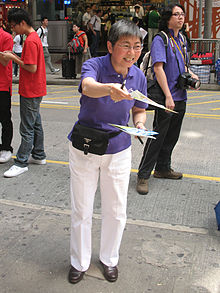User:Katyyeung/sandbox

Native women in Hong Kong were used to be situated within the context of Chinese family and society, in which they were treated the same as Mainland women or Taiwanese women.[1] Under the traditional Chinese patriarchy structure, the society was male-dominated, and women had a relatively subordinate familial role.[2] However, there is a cultural change in Hong Kong during the British colonial period with an emergence of Western culture (i.e. "Westernization"). A mix of traditional Chinese culture and Western values creates a unique culture of Hong Kong. Along with the rapid economic and social development of Hong Kong since the end of the Second World War, a significant improvement in the role of women has been witnessed, while male dominance society structure is still taking in place.[3] Hence, women studies in Hong Kong are slightly differ from China's.
Women in Hong Kong are generally more independent, monetarily autonomous, assertive, and career-focused; which makes them seem to be more prominent when comparing with women in some other Southeast Asian countries.[3]With the increase number of women in professional and managerial positions in recent decades, the terms of "female strong person" or "superwomen" are being used to describe women in Hong Kong. [3]
Gender Inequality[edit]
(See also Demographics of Hong Kong)
The statistical data from the Hong Kong national census in 2006 shows that the number of women in Hong Kong are increasing, while the number of men in Hong Kong are declining.[4] The figure of single Hong Kong women living alone increased to 43.8 percent comparing with 2001.[4] The numbers were as follows: 103,938 in 1996, 127,001 in 2001, and 182,648, in 2006. The gender ratio between men and women as of 2006 was at 1,000 females for every 912 males, and is expected to deteriorate further by 2036 (1,000 females for every 763 males).[4] The imbalance in the ratio between Hong Kong women and Hong Kong men was already evident in 2003 when there were 1,000 females for every 998 males.[4]
Education and career attainment[edit]
(See also History of Hong Kong & Education in Hong Kong)

The implementation of compulsory universal education in 1971, following with an extension to nine years in 1978, give rises to an increased amount of women elites.[5] [6]
According to the report of Hong Kong Annual Digest of Statistics by Census and Statistics Department of Hong Kong, a trend of universalism for boys and girls could be observed since 1970s; and girls' enrolment rate in general was higher than the boys' since 1980s.[6] Yet, the gap between male and female enrolment in post-secondary education has not changed much.[6] Women are still appeared to have a lower level of educational attainment by 2011.[7]
With the shift of Hong Kong's economy from manufacturing industry to services industry since 1980s, there is a growing demand for white collar workers. Abundant job opportunities are hence available for both men and women.[3]
Concerns[edit]
Ageing Issue[edit]
References[edit]
- ^ Jackson, S., Jieyu,L. & Juhyun, W., ed. (2008). East Asian sexualities : modernity, gender and new sexual cultures. London & New York: Zed Books. p. 195. ISBN 9781842778890.
{{cite book}}: CS1 maint: multiple names: editors list (link) - ^ Pearson, V. & Leung, B.K.P., ed. (1995). Women in Hong Kong. New York: Oxford University Press. p. 7. ISBN 0195859545.
{{cite book}}: CS1 maint: multiple names: editors list (link) - ^ a b c d Lee, Eliza W. Y. (2003). "4". Gender and change in Hong Kong : globalization, postcolonialism, and Chinese patriarchy. Vancouver, B.C.: UBC Press. p. 78. ISBN 0774809949. Retrieved 3 April 2013.
- ^ a b c d "Women and Men in Hong Kong (2006 version)" (PDF) (in English & Chinese). Hong Kong: Census and Statistics Department (Hong Kong). 2006. Retrieved 3 April 2013.
{{cite web}}: CS1 maint: unrecognized language (link) - ^ Jackson, S., Jieyu,L. & Juhyun, W., ed. (2008). East Asian sexualities : modernity, gender and new sexual cultures. London & New York: Zed Books. p. 195. ISBN 9781842778890.
{{cite book}}: CS1 maint: multiple names: editors list (link) - ^ a b c Cheung, F.M., ed. (1997). "2". EnGendering Hong Kong Society: A Gender Perspective of Women's Status. Hong Kong: The Chinese University Press. p. 15. ISBN 9622017363. Retrieved 3 April 2013.
- ^ "Women and Men in Hong Kong: Key Statistics" (PDF). Census and Statistics Department (Hong Kong). 2012. Retrieved 4 April 2013.
Further reading[edit]
- Jaschok, Maria; Miers, Suzanne, eds. (June 15, 1994). Women and Chinese patriarchy: submission, servitude, and escape. Zed Books. ISBN 978-1-85649-126-6. </bc>
Notes: Several chapters are dedicated to the historical status of women in Hong Kong.
- Wong, Odalia M. H. (December 2005). "The Socioeconomic Determinants of the Age at First Marriage among Women in Hong Kong". Journal of Family and Economic Issues. 26 (4): 529–550. doi:10.1007/s10834-005-7848-3. S2CID 143310618.
{{cite journal}}: CS1 maint: date and year (link) - Ho, Petula Sik-ying (August 2007). "Eternal Mothers or Flexible Housewives? Middle-aged Chinese Married Women in Hong Kong". Sex Roles. 57 (3): 249–265. doi:10.1007/s11199-007-9255-8. S2CID 144837465.
{{cite journal}}: CS1 maint: date and year (link) - Ngo, Hang-Yue (Autumn 1992). "Employment Status of Married Women in Hong Kong". Sociological Perspectives. 3. 35 (3): 475–488. doi:10.2307/1389330. JSTOR 1389330. S2CID 144428264.
{{cite journal}}: CS1 maint: date and year (link) - Hung, Suet Lin (January 2012). "Empowerment Groups for Women Migrating from China to Hong Kong". Social Work with Groups. 35 (1): 4–17. doi:10.1080/01609513.2011.580265. S2CID 143807648.
{{cite journal}}: CS1 maint: date and year (link) - "Understanding Violence Against Chinese Women in Hong Kong: An Analysis of Risk Factors With a Special Emphasis on the Role of In-Law Conflict". Violence Against Women. 14 (11): 1295–1312. November 2008. doi:10.1177/1077801208325088. hdl:10722/60557. PMID 18809848. S2CID 206666997.
{{cite journal}}: Unknown parameter|coauthors=ignored (|author=suggested) (help)CS1 maint: date and year (link)
External links[edit]
Category:Hong Kong culture
Category:Women's rights in Asia
Category:Women in Asia
Category:Hong Kong people
Category:History of Hong Kong

